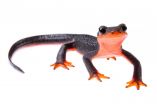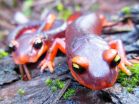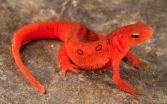(Press-News.org) A deadly fungus identified in 2013 could devastate native salamander populations in North America unless U.S. officials make an immediate effort to halt salamander importation, according to an urgent new report published today in the journal Science.
San Francisco State University biologist Vance Vredenburg, his graduate student Tiffany Yap and their colleagues at the University of California, Berkeley and the University of California, Los Angeles say the southeastern United States (particularly the southern extent of the Appalachian Mountain range and its southern neighboring region), the Pacific Northwest and the Sierra Nevada, and the central highlands of Mexico are at the highest risk for salamander declines and extinctions if the fatal Batrachochytrium salamandrivorans (Bsal) fungus makes its way into those regions.
Salamanders are popular worldwide as pets, and frequently traded across borders. That has scientists worried that the fungus could spread from Asia, where it likely originated, to other parts of the globe. Vredenburg and his coauthors on the study are asking the U.S. Fish and Wildlife Service to place an immediate ban on live salamander imports to the U.S. until there is a plan in place to detect and prevent the spread of Bsal. Although the ban has been supported by key scientists for some time, including in a prominent op-ed in the New York Times last year, the government has been slow to act.
"This is an imminent threat, and a place where policy could have a very positive effect," Vredenburg said. "We actually have a decent chance of preventing a major catastrophe."
Salamanders are one of the most abundant vertebrate animals in many North American ecosystems and play a number of key ecological roles. "They are very important predators of insects, but also an important part of the food chain," noted Vredenburg, an associate professor of biology.
Bsal likely originated in Asian species of salamander that are traded as popular pets around the world. When the fungus made its way into Europe through the pet trade, it caused a 96 percent fatality rate among the European salamander species that it infected. It was also fatal to American salamanders exposed to the fungus in the lab.
The blue-tailed fire-bellied newt (Cynops cyanurus), the Japanese fire-bellied newt (Cynops pyrrhogaster), and the Tam Dao or Vietnamese salamander (Paramesotriton deloustali) are thought to be the main carriers of Bsal. Alarmingly, 91 percent of pet salamanders imported to North America come from either the Cynops or Paramesotriton groups.
"We've made specific predictions, on the ground, of where North American species are most vulnerable to Bsal," said Vredenburg. "And the places that have the highest amount of trade in these salamanders happen to be in those high-risk areas."
To map out high-risk regions of Bsal infection in North America, the research team looked at habitats where the fungus might thrive, based on its Asian carrier locations, along with data on how many different species might be threatened in those areas and the location of major U.S. ports of entry for salamander trade between 2010 and 2014.
Vredenburg fears that the salamanders might be on the verge of an ecological crisis that is all too familiar to him. For more than a decade he has studied the impact of a similarly deadly fungus called Batrachochytrium dendrobatidis (Bd). More than 200 species of amphibians have gone extinct or are near to extinction as a result of Bd infection, making it the most devastating infectious wildlife disease ever recorded.
"I have seen the effects of Bd on frogs, to the point where I've seen tens of thousands of animals die in the wild in pristine areas, here in California, right in front of my eyes," Vredenburg said. "It is just an unbelievable sight to see all these dead animals."
The heartbreaking work might have a silver lining, he said, if it can be used to save the salamanders from a similar plight.
"One of the things that I find remarkable about this is that unlike when we first figured out what was going on with Bd, no one could even imagine that one pathogen could cause so much damage across all these different species, because we had never seen anything like that ever before," Vredenburg said. "What's encouraging about this time, with Bsal, is that the scientific community figured it out really quickly, and we can learn a lesson from the past."
Vredenburg is the co-founder of AmphibiaWeb, an online database of information on amphibian biology that receives 7.3 million queries each year. Salamanders are astonishing animals, he said, ranging from species that live 35 feet up in the trees to others that roll into balls and hurl themselves off cliffs to escape predators. The familiar California slender salamanders, found all over Northern California, are one of the groups most threatened by Bsal infection.
"They're incredibly diverse, they've been around for tens of millions of years, and the thought of losing them because of human error, humans moving pathogens around by accident, is just a terrible thought," Vredenburg said. "And it's preventable."
INFORMATION:
"Averting a North American biodiversity crisis" by Tiffany A. Yap, Michelle S. Koo, Richard F. Ambrose David B. Wake and Vance Vredenburg was published July 31 in Science.
Scientists at Columbia University's Mailman School of Public Health and the School of Public Health of Li Ka Shing Faculty of Medicine at the University of Hong Kong have shown for the first time that it is possible to predict the timing and intensity of influenza outbreaks in subtropical climates like Hong Kong where flu seasons can occur at different times and more than once during a year. Results appear online in the journal PLOS Computational Biology.
Since the 2013-2014 season, the Mailman School scientists have published weekly regional flu forecasts for over 100 ...
Worldwide, influenza kills an estimated 250,000 to 500,000 people each year. A new study publishing in PLOS Computational Biology has shown that for the first time it is possible to predict the timing and intensity of influenza outbreaks in subtropical climates, such as Hong Kong, where flu seasons can occur at irregular intervals year-round.
The team of scientists from Columbia University's Mailman School of Public Health and the University of Hong Kong used data from a network of 50 outpatient clinics and laboratory reports in Hong Kong from 1998 to 2013 as a test case ...
This news release is available in Japanese.
During the first ever landing of a probe on a comet, the world held its breath as Philae survived a bouncy landing on comet 67P/Churyumov-Gerasimenko on November 12, 2014. This special issue of Science highlights seven new studies that delve further into the data that has been transmitted back by Philae. In a detailed account, Jens Biele et al. describe the critical moments where Philae descends on 67P, only to bounce off the soft, intended landing area and finally settle on a harder surface farther away. Analysis ...
This news release is available in Japanese.
By studying how water striders jump on water, Je-Sung Koh and colleagues have created a robot that can successfully launch itself from the surface of water. As the team watched the water strider jump on water surfaces using high-speed cameras, they noticed that the long legs accelerate gradually, so that the water surface doesn't retreat too quickly and lose contact with the legs. Using a theoretical model of a flexible cylinder floating on liquid, the authors found that the maximum force of the water striders' legs is always ...
This news release is available in Japanese.
The international pet trade threatens to spread a deadly fungal infection to North America's rich wild salamander population and must be frozen, according to the authors of this Policy Forum. Batrachochytrium salamandrivorans (Bsal) is a highly virulent, often fatal fungus that infects salamanders, and there is no effective way to control it after it infects a wild population, say Tiffany Yap and colleagues. It is theorized that Bsal started in Asia and spread to wild European salamanders via the international pet ...
SAN FRANCISCO, CA - July 30, 2015 - A study released today at the Society of NeuroInterventional Surgery 12th Annual Meeting in San Francisco, California, indicates that strict adherence to two commonly-used tools to weigh the risk of treating unruptured aneurysms may not prevent the majority of morbidity-mortality outcomes associated with ruptured intracranial aneurysms. Thus, the International Study of Unruptured Intracranial Aneurysms (ISUIA) criteria and the PHASES score require additional research to determine their effectiveness.
Published in 2003, the ISUIA study ...
Boston, MA -- New research from Harvard T.H. Chan School of Public Health describes a molecular mechanism that helps explain how obesity-related inflammation can lead to type 2 diabetes. The findings describe a surprising connection between two molecular processes that are known to be involved in the development of metabolic disease--inflammation and endoplasmic reticulum (ER) dysfunction--and suggest that targeting this connection could aid in the development of new therapies.
The study will be published in the July 31, 2015 issue of Science.
Specifically, the researchers ...
Scientists have long worked to understand how crystals grow into complex shapes. Crystals are important in materials from skeletons and shells to soils and semiconductor materials, but much is unknown about how they form.
Now, an international group of researchers has shown how nature uses a variety of pathways to grow crystals that go beyond the classical, one-atom-at-a-time route.
The findings, published today (Thursday, July 30) in Science, have implications for decades-old questions in science and technology regarding how animals and plants grow minerals into shapes ...
IgA deficiency is one of the most common genetic immunodeficiency disorders in humans and is associated with an insufficiency or complete absence of the antibody IgA. Researchers led from Uppsala University and Karolinska Institutet in Sweden have now performed the first comparative genetic study of IgA deficiency by using the dog as genetic disease model. Novel candidate genes have been identified and the results are published in PLOS ONE.
People with low IgA are at higher risk for developing recurrent infections, allergies and autoimmunity. The underlying genetic factors ...
Highly active anti-retroviral therapy (HAART) has helped millions survive the human immunodeficiency virus (HIV). Unfortunately, HIV has a built-in survival mechanism, creating reservoirs of latent, inactive virus that are invisible to both HAART and the immune system.
But now, researchers at UC Davis have identified a compound that activates latent HIV, offering the tantalizing possibility that the virus can be flushed out of the silent reservoirs and fully cured. Even better, the compound (PEP005) is already approved by the FDA. The study was published in the journal ...





